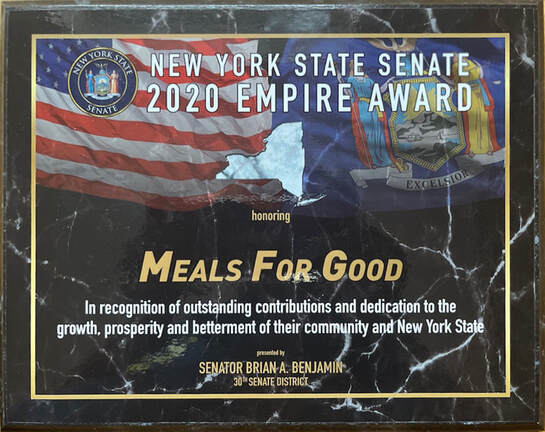Meals For Good works with food pantries and community based organizations to help alleviate food insecurity in New York City.
HOW WE BEGAN
From the beginning, Meals For Good has aimed to help local family farmers and food pantries meet the needs of New York City residents.
We did this by partnering with restaurants, who added between $0.25 - $1.00 to one food item on their menu for at least six months. Every time someone ordered that item, the additional money went to Meals For Good, which gave it to a food pantry local to the restaurant. The pantries used this money to buy fresh produce through GrowNYC, which only works with local and regional family farms. As the number of restaurant partners grew, so did the number of pantries we were able to help.
This supported the people who stand in pantry lines, and our local farmers as well. And it showed the community spirit of New York City’s restaurants.
We did this by partnering with restaurants, who added between $0.25 - $1.00 to one food item on their menu for at least six months. Every time someone ordered that item, the additional money went to Meals For Good, which gave it to a food pantry local to the restaurant. The pantries used this money to buy fresh produce through GrowNYC, which only works with local and regional family farms. As the number of restaurant partners grew, so did the number of pantries we were able to help.
This supported the people who stand in pantry lines, and our local farmers as well. And it showed the community spirit of New York City’s restaurants.
OUR WORK DURING THE HEIGHT OF COVID
Like so many other organizations, we had to pivot in response to COVID-19.
The pandemic has had catastrophic consequences for the restaurant industry, as well as New York City residents who had already struggled to access the food they needed.
In response, we’ve sought out new ways to fight food insecurity in New York City, continuing to work with local farms to help families buy fresh produce from local farmers but adding groceries that families were missing. We were looking for the missing links - providing people with food they could not find (or buy) elsewhere. Here are some of the work we've done with generous donations from individuals and non-profits :
The pandemic has had catastrophic consequences for the restaurant industry, as well as New York City residents who had already struggled to access the food they needed.
In response, we’ve sought out new ways to fight food insecurity in New York City, continuing to work with local farms to help families buy fresh produce from local farmers but adding groceries that families were missing. We were looking for the missing links - providing people with food they could not find (or buy) elsewhere. Here are some of the work we've done with generous donations from individuals and non-profits :
- Partnered with https://indivisibleharlem.com to distribute local, fresh produce and other groceries to 400 families in conjunction with Harlem's State Senator. Read more about the joint effort to distribute 400 boxes of food.
- Distributed thousands of Health Bucks—$2.00 coupons that can be used in over 144 farmers market and food box sites in New York City. This gave our Harlem families a chance to choose the fruits and vegetables they liked best.
Our distribution network included other community non-profits that distributed the Health Bucks to those families in domestic violence shelters, those who were undocumented, those who were post incarceration and getting back on their feet.
Distributing Health Bucks is not only a substantial approach to helping to reduce food insecurity , but an additional way to support our farmers. Read more about the grant that funded our Health Bucks distribution. - In November and December we teamed up again with Indivisible Harlem to help out two local food pantries that did not have enough food for Thanksgiving distribution. You may have heard, but food pantries have doubled and tripled their numbers since COVID and are struggling to keep up even in 2022.
- We also gave out vouchers for turkeys to a New York City Housing Development site and delivered fresh produce to another for Thanksgiving week.
- For Christmas we teamed up with Harlem Grown, a local urban farm and the chef JJ Johnson of Field Trip and had meals sent to 52 families with 118 children who were living in domestic abuse shelters in Central Harlem. We also gave vouchers for groceries to 30 families living in shelters in East Harlem.
- In January and February 2021, Meals For Good distributed groceries to unemployed and undocumented restaurant workers. We have done this twice so far for Harlem restaurant workers only. Their haul included a whole chicken as well as fruits and vegetables!
- Also in January, we bought groceries for 60 families in Central Harlem (many of them Seniors) and distributed supermarket vouchers to a dance troupe in East Harlem that works with trans kids, many of whom have been disowned by their families.
- We did a survey of 250 pantry clients with https://brotherhood-sistersol.org and found that families were missing Masa Harina (flour), tortillas and coffee. So Meals For Good bought enough for everyone for two months.
- In the Spring we supplied avocados, eggs and lettuce to many free fridges https://nycfridge.com in Harlem and the South Bronx .
- And of course, we are always continuing to donate fresh produce to underfunded food pantries.
- In June and July 2021, community groups in East Harlem distributed $20,000 worth of supermarket vouchers to families in need. 700 adults and over 600 children were able to buy meat, fresh vegetables and fruit as well as basics such as eggs, corn oil and coffee (the results are here: https://www.nycfoodpolicy.org/wp-content/uploads/2022/06/Meals-for-Good-Grocery-Store-Incentive-Program.pdf
- In November, 2021 we teamed up again with Harlem Grown and Indivisible Harlem to help pay for and pack over 200 bags of turkeys and fresh produce to be delivered to families in need. We also bought local produce for smaller pantries in the area to ensure that their clients received the fruit and vegetables that are so important to good health and good eating!
- In January and February 0f 2022, when donations are usually scarce, we increased our food donations to pantries, making sure that those waiting on line in the snow and cold, could at least take home fresh produce.
- Over the spring we tested out the vouchers again, this time with $35,000 reaching families with young children, translating information in Spanish and Mandarin as well as English, resulting in a successful redemption of over 90%. We believe this is a novel, and respectful approach to helping people obtain the groceries they need and we are now raising money to work with community based organizations in all five boroughs.
- And of course, we continue to give grants for local and regional produce to underfunded pantries.

